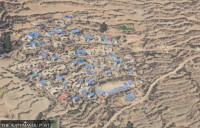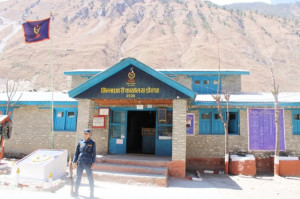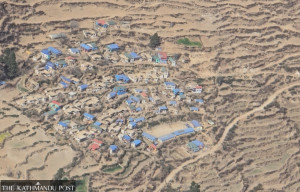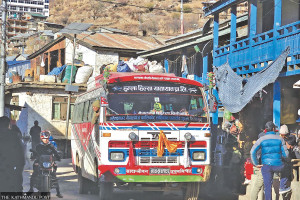Karnali Province
Historical palaces, public buildings hit by Jajarkot earthquake await reconstruction
More than 300 government-owned and community buildings in Jajarkot were damaged by the earthquake. Thousands of people are still living in tents.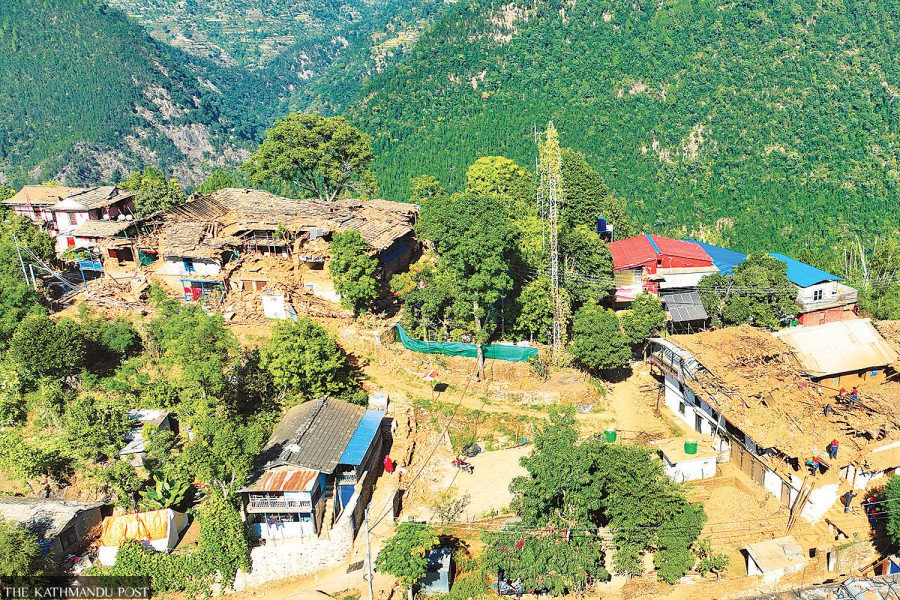
Krishna Prasad Gautam & Harihar Singh Rathour
The historical palaces at Thaple and Pipaldanda of Khalanga, the district headquarters of Jajarkot, were destroyed by the magnitude 6.4 earthquake on November 3, 2023. But even two months after the disaster, the quake-ravaged structures have yet to be pulled down and the sites cleared.
Two palaces at Thaple were occupied by some government offices, a hotel and 20 families. “We are yet to take out our belongings from the ruined palace. The damaged structure should be levelled even to get government aid for temporary housing,” said Bishwa Bikram Shah who had been running a homestay at one of the quake-damaged palaces. “It will take a lot of money to pull down the structure and to remove the rubble. Also, there is no space to dump the timber, bricks and other debris from the damaged structure.”
“The historical palaces were destroyed by the earthquake two months ago. We have been urging the federal government to restart the reconstruction work,” said Dipak Jung Shah, the former parliamentarian who is one of the owners of the palaces.
The damaged four palaces are privately-owned and registered in the names of 16 individuals.
The main palace in Khalanga also sustained damage in the disaster. The palace is believed to have been built some 138 years ago by the sons of the king of Jajarkot Junga Bahadur Shah. The District Administration Office operated from the palace before the earthquake.
According to Krishna Bikram Shah, one of the owners of Mathillo Durbar at Thaple, discussions are underway to bring the land of the quake-damaged Durbar under the ownership of the Department of Archaeology and start reconstruction by the federal government. “Negotiations are underway on conditions such as—the owners can only use the property but not sell it, the property cannot be divided among the owners and they cannot use the property as collateral to take loans from financial institutions,” said Krishna Bikram.
The Tallo Durbar at Thaple was a four-faceted durbar with a courtyard at the centre. “The debris of the palace is massive. It will take a good deal of resources to clear the site. The government should take initiatives for its reconstruction,” said Krishna Bikram. According to him, the main durbar was constructed circa 1885 while Tallo Durbar was built in around 1893.
The federal government included the main palace at Khalanga on the list of 100 tourist destinations in the country for the Visit Nepal 2020 campaign. But the campaign was postponed due to the Covid pandemic. “The palaces in Jajarkot have archaeological and historical significance. The quake-ravaged monuments should be reconstructed in the same traditional style and size,” said Chief District Officer of Jajarkot Suresh Sunar.
Besides the historical palaces, more than 300 government-owned and community-owned buildings were damaged by the earthquake. However, the district disaster management committee has recorded only 152 government and community buildings that were destroyed by the disaster so far.
“The actual data on the government-owned and community-owned buildings destroyed in the disaster is yet to be assessed. Details on the school buildings damaged or destroyed have yet to come. We are currently working to manage private housing. Work to assess the damage caused to public and community buildings will begin once we complete the task of providing the first tranche of housing aid to the earthquake-displaced families,” said Sunar. According to him, around three dozen government offices have been providing their services from the tents.
The earthquake also damaged several police posts in Jajarkot, Rukum West, Salyan, Jumla and Kalikot districts. According to the Karnali Province Police Office in Birendranagar, a total of 54 police posts in the province were damaged by the earthquake.
“The security personnel slept in tents and conducted rescue work in the aftermath of the disaster. They have been carrying out various works such as preparing a public inquiry report based on damage assessment,” said Deputy Inspector General of Police Bhim Prasad Dhakal. According to him, 33 police buildings in Jajarkot, 12 in Rukum West, four in Jumla, three in Salyan and two in Kalikot sustained damage in the disaster. Four buildings of the District Police Office in Jajarkot, 12 area police offices, 10 police posts and six temporary police posts incurred damage in the district.
According to the data available at the Karnali provincial government, the earthquake with its epicentre in Jajarkot displaced 60,478 families in the province. However, even two months after the disaster, only around 17,000 temporary huts have been built as thousands of displaced to languish under flimsy tarpaulin tents.
The federal government, according to the Temporary Housing Construction Grant Procedure for Earthquake-affected Households-2023, provides a total of Rs50,000 in two tranches to each family whose house was completely or partially damaged and has become inhabitable. However, many beneficiaries are yet to receive the aid to build temporary shelters.
The data of the province’s Internal Affairs Ministry shows that there are 35,140 applicants in Jajarkot while the number of applicants in Rukum West and Salyan are 23,608 and 1,730, respectively.
After the earthquake, 36 people died in Jajarkot and Rukum West due to cold, diarrahoea, chronic illnesses, and fever.




 5.81°C Kathmandu
5.81°C Kathmandu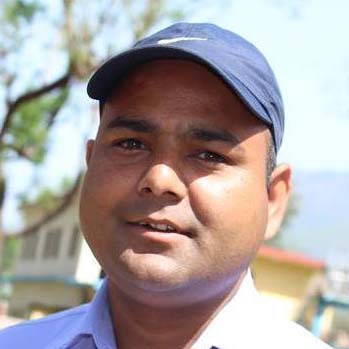
-(2).jpg)

